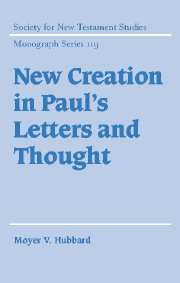Book contents
- Frontmatter
- Contents
- Acknowledgments
- List of abbreviations
- 1 Introduction: the current debate
- PART I NEW CREATION: CENTRAL JEWISH TEXTS
- Part II FROM DEATH TO LIFE: NEW CREATION IN THE CONTOURS OF PAUL'S THOUGHT
- Part III THE OLD AND THE NEW: NEW CREATION IN THE CONTEXT OF PAUL'S LETTERS
- 10 If anyone be in Christ: 2 Corinthians 5.17
- 11 Neither circumcision nor uncircumcision: Galatians 6.15
- 12 Summary and conclusions
- References
- Index of passages cited
- Index of modern authors
12 - Summary and conclusions
Published online by Cambridge University Press: 02 December 2009
- Frontmatter
- Contents
- Acknowledgments
- List of abbreviations
- 1 Introduction: the current debate
- PART I NEW CREATION: CENTRAL JEWISH TEXTS
- Part II FROM DEATH TO LIFE: NEW CREATION IN THE CONTOURS OF PAUL'S THOUGHT
- Part III THE OLD AND THE NEW: NEW CREATION IN THE CONTEXT OF PAUL'S LETTERS
- 10 If anyone be in Christ: 2 Corinthians 5.17
- 11 Neither circumcision nor uncircumcision: Galatians 6.15
- 12 Summary and conclusions
- References
- Index of passages cited
- Index of modern authors
Summary
New creation in the context of Paul's letters and the contours of his thought
From death to life
Beginning with the broader theological context, the first point to be reiterated is that Paul's new-creation motif belongs to that family of passages whose foundational metaphor is the movement from death to life, and 2 Corinthians 5.17 and Galatians 6.15 should not be treated in isolation from this crucial so teriological matrix. The examination of initiatory symbolism in chapter 5 emphasized the interconnectedness of such physiomorphic transformation symbolism, while also locating the Pauline material within a larger, universal pattern of symbolic expression. Death–life symbolism is hardly unique to Paul, and a consideration of this wider context adds definition and clarity to the same imagery in Paul's letters.
The primary purpose of initiatory rituals is to mark the initiate's transition from one status to another. While the symbolism varies from culture to culture, the common emphases of the death–life drama are transformation (a change of identity and status), demarcation (separation from uninitiated), and empowerment (enablement for service within a new social structure). While the focus of these life-crisis rituals is on the individual, their ultimate aim is “the transformation of raw human material into socially responsible persons”. The new individual is the building-block of the new community, and the perspective of the apostle Paul fits comfortably within this broader religious framework.
The discussion of death–life symbolism inevitably raised the issue of new-birth imagery, the two being intimately connected in religious symbolism from antiquity. Indeed, “resurrection, ” “new birth,” and “new creation” are merely alternative formulations of the “life” side of the death–life equation, and the argument of this monograph is that Paul's letters provide further evidence of this common association.
- Type
- Chapter
- Information
- New Creation in Paul's Letters and Thought , pp. 233 - 241Publisher: Cambridge University PressPrint publication year: 2002



